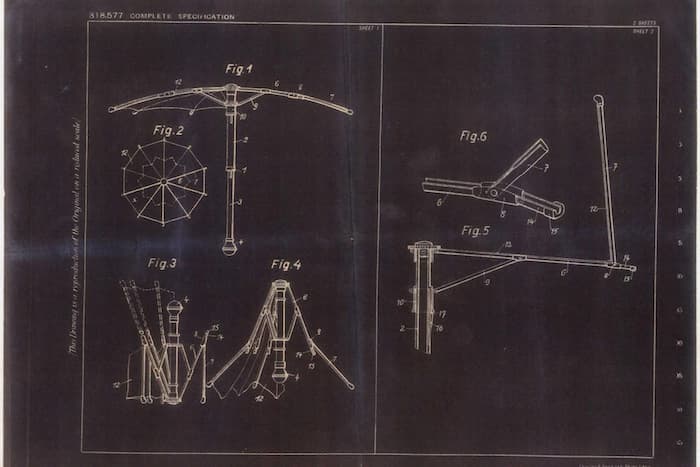
20 February, 2025
The Birth of the Compact Umbrella
The compact umbrella has a fascinating history marked by continual design improvements. This journey from the traditional, cumbersome umbrellas to the sleek, portable versions we use today is a tale of innovation and practicality.
The Early Beginnings
The umbrella's history begins in several ancient civilizations, where it served more as a status symbol than a practical tool for rain protection.
Ancient Egypt
Symbol of Royalty: In ancient Egypt, they were seen as symbols of status and divinity. Only pharaohs and noble figures had the privilege of using them.
Design: They were typically made from palm leaves or feathers. They were large and required bearers to carry them, highlighting the owner's status.
Ancient Greece and Rome
Cultural Symbolism: In these cultures, umbrellas, known as 'parasols', were primarily used for shade rather than rain protection. They were associated with women of high social standing.
Construction: They were often made from light fabrics like silk and were mounted on wooden frames. Their use as sun protection made them different from the rain umbrellas of today.
Ancient China
Innovation in Waterproofing: China is credited with creating the first waterproof umbrellas, using wax and lacquer to coat paper umbrellas.
Ceremonial Use: These umbrellas were part of ceremonial attire and were also symbols of rank. The colour and design of one were indicators of the user’s social status.

The Emergence of the Portable Umbrella
The transition to a more portable form of the umbrella began in the 18th century, although these early versions were still quite cumbersome.
18th Century Developments
Material Use: Umbrellas in this era were constructed from wood or whalebone. Whalebone, being flexible and durable, was particularly popular.
Fabric: The canopies were made from heavy canvas, which provided durability but also added to the weight.
Adoption by the Public: Despite their weight, they gained popularity, especially in Europe, as a practical tool against rain. Their use was no longer limited to the elite.
Challenges
Cumbersome Nature: They were heavy and difficult to carry. Their size and weight made them impractical for frequent use or for carrying on long journeys.
Limited Portability: The concept of one that could be easily folded and carried around was still far off. The focus was more on durability and effectiveness against the elements rather than on portability.
The Introduction of Steel
The early 1900s marked a pivotal moment in the evolution of the umbrella with the introduction of steel in their construction. This innovation significantly altered the umbrella's design, making it more user-friendly and setting a new standard for portability and practicality.
Background and Context
Prior Materials: Before the advent of steel, they were typically made with frames of wood or whalebone. While durable, these materials made the umbrellas heavy and cumbersome.
Industrial Revolution: The late 19th and early 20th centuries were a period of rapid industrial advancement. The mass production capabilities and advancements in metalworking brought by the Industrial Revolution played a crucial role in the introduction of steel in various products, including umbrellas.
Advantages of Steel
Lightweight: Steel, being significantly lighter than whalebone and wood, drastically reduced the overall weight. This made umbrellas more manageable and less tiring to carry around.
Flexibility: Its flexibility allowed for more resilient frames. Umbrellas with steel frames could better withstand wind and were less likely to break or become deformed.
Durability: Despite its lighter weight, it offered superior durability compared to previous materials. This meant that umbrellas could now have a longer lifespan.
Impact on Umbrella Design
Compact Designs: The use of steel paved the way for more compact and collapsible designs. Designers could now experiment with mechanisms that allowed umbrellas to be folded into more convenient sizes.
Widespread Use: With these improvements, umbrellas became more practical for daily use. This period saw a significant increase in the public's use of umbrellas, transcending social classes and becoming a common accessory for the average person.
Design Versatility: Steel frames allowed for a greater variety of shapes and sizes. This versatility led to the development of different styles, catering to various preferences and needs.
Technological and Social Implications
Technological Advancement: The introduction of steel was part of a broader trend of using new materials and technologies to improve everyday items.
Social Impact: The improved design and practicality of them made them more accessible and affordable, which in turn had a democratising effect. Umbrellas were no longer seen as luxury items or symbols of status but as a practical tool for everyone.

The Birth of the Compact Umbrella
The compact umbrella owes its existence to the ingenuity and innovation of two key figures: Hans Haupt and Bradford E. Phillips. Their contributions in the 20th century transformed the umbrella from a cumbersome accessory to a convenient, portable device.
Hans Haupt: The Pioneer of the Pocket Umbrella
Hans Haupt's invention of the pocket umbrella in the 1930s stands as a landmark in the history of personal accessories. Haupt's work was driven by a combination of personal need and engineering acumen, leading to a product that changed the way people viewed and used umbrellas.
Background and Personal Motivation
Struggle with Disability: Haupt's journey toward innovation was deeply personal. Suffering from a physical disability, he found handling both a walking stick and a traditional umbrella cumbersome and impractical. This difficulty was particularly pronounced in inclement weather, where carrying both items was a necessity.
Desire for Independence: His disability fueled his desire for greater independence and mobility. This personal need was the catalyst for his pursuit of a more practical solution, leading him to conceptualise an umbrella that could alleviate his daily challenges.
Engineering Expertise
Professional Background: As an engineer, he had the technical knowledge and skills necessary to turn his idea into a tangible product. His understanding of mechanics and materials was crucial in the development of a new type of umbrella.
Innovative Approach: He approached the problem with an engineer’s mindset, looking for ways to improve upon the existing bulky designs of traditional umbrellas. His focus was on creating something that was not just functional as an umbrella but also as a mobility aid.
The Invention: A Dual-Purpose Umbrella
Telescopic Handle: The most significant feature of his invention was the telescopic handle. This innovative design allowed the umbrella to be extended for use and then collapsed into a compact form. The mechanism was similar to what you might find in a telescope, where segments of the handle slide into each other, greatly reducing the umbrella's length when not in use.
Compactness: The ability to collapse it meant it could be easily stored in a pocket or handbag, a significant departure from the long, rigid umbrellas of the time. This feature made it highly portable and convenient for everyday use.
Dual Functionality: Haupt's design addressed his need for a mobility aid. When collapsed, the umbrella was sturdy enough to be used as a walking stick, thus serving a dual purpose. This dual functionality was a thoughtful response to his personal challenges and represented a major step forward in umbrella design.

Bradford E. Phillips: Advancing the Compact Umbrella
Bradford E. Phillips, an American inventor active in the 1960s, significantly advanced the design of the compact umbrella. His work refined and expanded upon the concept of portability in umbrella design, taking it to unprecedented levels of practicality and convenience.
Background and Drive for Innovation
Era of Innovation: The 1960s were a time of significant technological and design innovation. In this context, Phillips turned his attention to the everyday umbrella, seeking to improve its design in a way that would match the dynamic and mobile lifestyle of the era.
Observing Limitations: Phillips noted the limitations in existing compact umbrella designs. While they were more portable than traditional models, there was still room for improvement, especially in terms of reducing their size when collapsed.
Patenting the Compact Design
Securing a Patent: Phillips' work culminated in the securing of a patent for a new design. This patent was not just a recognition of his invention but also a testament to its novelty and practical significance.
Improvement over Previous Models: His design stood out for its superior practicality and ease of use. It addressed many of the shortcomings of earlier models and set a new standard in design.
The Telescopic Folding Mechanism
Innovative Mechanism: The cornerstone of his invention was a sophisticated telescopic folding mechanism. This mechanism allowed the umbrella to not only collapse along its length (like the earlier pocket umbrellas) but also to fold at its canopy.
Compact Size: This dual folding capability meant it could be reduced to a size far more compact than any previous model. This was a significant improvement, as it allowed the umbrella to be easily stored in small bags, purses, or even pockets.
The Impact of Phillips' Invention
Widespread Adoption: his design was quickly embraced by the public. Its practicality resonated with the needs of a fast-paced, space-conscious society, making it an instant success.
Influence on Future Designs: Perhaps the most significant impact of his invention was its influence on future innovations in the umbrella industry. His design laid the groundwork for further developments in materials (like lightweight metals and synthetic fabrics), durability, and functionality (including automated opening and closing mechanisms).
The compact umbrella, as it is known today, is a product of continuous innovation, but it was the foundational work of Hans Haupt and Bradford E. Phillips that truly revolutionised its design. Haupt introduced the concept of an umbrella that could be both compact and dual-purpose, while Phillips perfected the design with a folding mechanism that made it more practical and portable than ever. Their contributions have made the compact umbrella a quintessential item in the daily lives of millions around the world, combining convenience, efficiency, and functionality.

Recent Innovations and Future Trends
The journey didn't stop there. The 21st century has seen numerous advancements:
Ultra-Lightweight Frames: The use of aluminium and fibreglass has further reduced the weight, making umbrellas almost featherlight.
Wind-Resistance Technologies: Modern ones boast wind-resistant designs, some with vented or double-layered canopies to withstand high winds.
Eco-Friendly Materials: With growing environmental concerns, there’s a trend towards using recycled materials and biodegradable fabrics.
Smart Features: The integration of smart technology, such as location tracking and weather forecast connectivity, is an emerging trend.
Customisation and Aesthetics: From personalised handles to a variety of canopy designs, the focus on aesthetics is more prominent than ever.
Conclusion
The compact umbrella, now a staple in our daily lives, exemplifies how necessity and innovation can transform a simple concept into an essential, sophisticated product. As we move forward, it's likely that this evolution will continue, with technology and eco-conscious designs leading the way in the umbrella industry.
The Umbrellas Only Team
